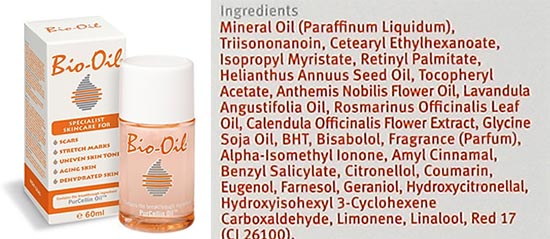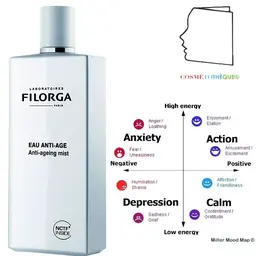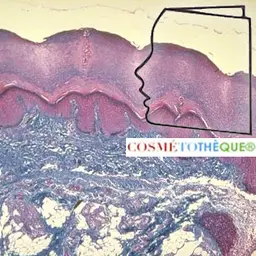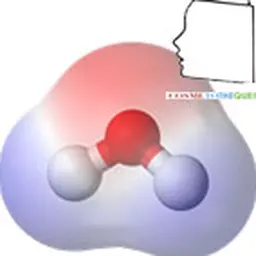
From Greek"bios", life, and"mimesis", imitation, biomimicry observes and draws inspiration from nature to produce environmentally friendly applications. This global approach holds great promise for discovery. We do not often enough remember that this subject, particularly topical, has already been the subject of much research in the past, with, in some cases, quite interesting applications.
The birth of biomimicry?
As part of the"Forgotten Concepts" series " of the Cosmetotheque, we tell you today the story of a rather particular ingredient that some may have forgotten, but not all, since it is currently one of the basic active ingredients of a particularly"succesfull" product. Michelle Vincent tells us this story and describes more recent uses.
Jean Claude Le Joliff
This ingredient, almost banal, could have gone unnoticed and finally been forgotten. This was without counting on the marketing genius of two businessmen, the Letschert brothers, who bought the company Union Swiss in 2000, and will focus on a nugget, the brand Bio-Oil. Here's how a simple synthetic chemical compound, registered under the brand name PurCellin™ by Dragoco (now Symrise), will become a star ingredient, 50 years later, thanks to a storytelling tailor-made.
Originally, Dragoco, chemistry and biomimicry
At the dawn of the 20th century, emulsifiers appeared and revolutionized the skin care market. Until then, vegetable oils were widely used to treat the skin and mind in various ancestral medicines. The products were often ointments, anhydrous mixtures almost essentially consisting of fat and without water. Emulsifier technology in the 1940s contributed to the development of a new generation of products; water/greasy mixing, improving product performance and approval and significantly reducing formula costs. Cosmetics will experience unprecedented democratization. Then chemists can have a field day.
The study of esters, very common chemical substances, combinations of an alcohol and a fatty acid, present in many fatty substances (oils, waxes), will allow to synthesize a multitude of components, among others for the cosmetic industry.
Among them, Purcellin™(registered trademark) oil which is none other than the trade name of Cetearyl octanoate (now called Cetearyl ethylhexanoate). This synthetic emollient has been widely used for many years and in many products. It is commonly found in hair and skin care formulations, as are Crodamol™, Tegosoft® and Luvitol®.
The Dragoco concept
In the 1920s, the use of components of mineral origin instead of vegetable fats will prove very interesting. The chemical properties and in particular the non-oxidation (rancidity phenomenon) of these substitutes make them very common bases for cosmetics (cf. Nivéa). Thus, creams formulated with"chemical" oils are whiter, less sticky and easier to perfume; a real asset. However, vegetable oils retain a strong sympathy capital since they have been used for decades, are more natural and have a better affinity with the skin. According to Dragoco, the downside of mineral oils (saturated carbon chains) is that they make the skin totally impermeable by forming an occlusive film on the surface, which prevents exchanges with the external environment. In the long term, this can lead to negative symptoms related to occlusion (e (e.g., imprisonment of substances by others using various mechanisms) Excessive skin temperature, hyperhydration of the stratum corneum, changes in microbial flora, etc. This mechanism has even been associated by some with what has been called"cosmetic acne", also described under the term comedogenic effect.
The challenge was to find greasy substances that were more compatible with the skin. After the Second World War, sheep's wool fat, the famous lanolin, proved promising because it was possible to purify it. It was widely used by industry in the 1950s, mixed with chemical fats for its anti-occlusive but film-forming properties. But research will continue to improve the application and texture of creams to make them more sensory.
Many animal fats were studied and, thanks to the development of analytical methods, the one that caught Dragoco's attention was an oil found in the uropygeal glands of birds (located at the rump), specific sebaceous glands that produce a complex mixture of fats and waxes. This mixture was used to maintain the plumage by acting on the flexibility of the feathers and as an antimicrobial agent, while ensuring a protective effect. The discovery of this oil, which had a repellent power on water and remarkable spreading properties, will immediately intrigue Dragoco chemists. It showed very interesting properties for the skin but also for the hair. But it was produced in very small quantities by birds and could not be recovered for industrial application.
After extensive analytical research, it was shown that the properties of these oils of the uropygeal glands were associated with the high concentration of esters of saturated long-branched fatty acids (Dragoco report 4/1985), mainly waxy esters, of complex composition. Copying by synthesis being very delicate and very long, research was carried out on other esters with very similar properties, in particular the palmito stearic ester of 2-ethylhexyl alcohol. This ingredient has similarities with reference oils.
The objective is then to synthesize it. Thus was born 2-ethylhexyl ester, a mixture of stearic and palmitic acids, which will be called Pur-Cellin oil. This new oil had very interesting properties, in particular the absence of odour and colour, as well as remarkable resistance to oxidation. Just like the oils of uropygian glands, it showed remarkable properties of wettability with respect to the skin, with a spreading much higher than mineral oils, while forming a thin and non-sticky film, also present an occlusive power clearly inferior to mineral oils and thus improving the compatibility of the products with the skin.
At the same time, a second fatty acid ester is synthesized by Dragoco, the Pur-Cellin, solid this time. Dragoco introduced two compounds into the cosmetics industry, Pur-Cellin Oil and Pur-Cellin, which were later renamed PCL Liquid and PCL solid in many countries. By mixing these two PCLs, the melting point and water repellency of the fat phase of an emulsion can be adjusted and controlled. When the brand Purcellin™ was patented by Dragoco in the United States in 1961, these active ingredients were described as an oil or synthetic fat based on the oil from the glands of birds and could be used in the preparation of cosmetics (Copy Brevet Dragoco Pur-Cellin).
This new compound was a remarkable alternative to vegetable fats and the common triptych in formulation: vegetable oils/mineral oil/lanolin. A real breakthrough for cosmetic formulations, bringing modernity and a non-greasy, non-sticky, very soft sensory touch, while forming a protective and"breathable" film for the skin.
The success is immediate in the United States where Purcellin™ will be found during a use survey in 1976 to demonstrate the safety of these substances in no less than 135 bodies of formulas, both creams and make-up products, hair care, baby care, etc.. One expert even estimates that the product, in the 80s, after 25 years of use by the industry, would have been sold at more than 10 billion units!!! (Dragoco Report 4/1985). In Europe, this ingredient is also widely used in many products.
Dieter Beier, a visionary chemist
Throughout his life, Dieter Beier, a German chemist living in South Africa, conducted research on fatty substances used in cosmetics. And he was no stranger to this industry, since the family business, Beier, had been at the origin of the development of Oil of Olay skin care products.
In 1972, Dieter Beier acquired Union Suisse, a South African distribution company for European skincare products. Dieter Beier's idea to research oils was based on his own experience with a range of Swiss skin care products called Vitamol, which the Swiss Union licensed at the time. Vitamol was one of the first care ranges containing vitamins, with more than twenty-five products. All Vitamol products were creams except one oil, which was by far the best-selling in the range and Dieter Beier's favourite for treating his own very dry skin. After more than ten years of research, he launched Bio-Oil in 1987.
Bio-Oil, a success story built on a forgotten concept
In 2000, the Letschert brothers bought the Swiss Union and repositioned the Bio-Oil brand by internationalizing it. They're bringing it up to date with Dragoco's star ingredient. For the brand," This specialized treatment includes a unique ingredient, PurCellin Oil™, which ensures a non-greasy consistency and optimal absorption. This oily base allows the suspension of vitamins and a combination of plant extracts (Calendula oil, Lavender, Chamomile and Rosemary). ". And here we are, recycling is finalized.

Bio-Oil (renamed Bi-Oil in France for regulatory reasons) has been one of the world's biggest successes in the dermocosmetics segment over the past ten years: 32 bottles sold every minute worldwide, no. 1 in scar and stretch mark products in 20 countries since its worldwide launch in 2002.
|
About Dragoco Dragoco, originally called Dragon Company and based mainly in Holzminden, Germany, was founded by Carl-Wilhelm Gerberding in 1919, around fragrances and flavors. Quickly, it completes its catalogue with products for cosmetic formulation. Dragoco's economic growth has enabled it to develop throughout the world: Italy (Milan), United States (New York), Austria, France (Paris), Great Britain, Mexico, Spain, Australia, Switzerland, Canada, Brazil, Asia since 1975 and Africa since 1984. The company integrates the Symrise group, created in 2003 following the merger of Haarmann & Reimer (H&R) and Dragoco, both based in Holzminden. |
|
We owe this new contribution to Michelle Vincent.
|

 Michelle graduated from ENSAM Montpellier (now SupAgro) in food science and started her career as a quality engineer in the Intermarché group. In 1993, fate led her to a more glamorous universe, that of cosmetics. She joined Chanel in Neuilly sur Seine. At the same time, at the end of 2012, she created her consulting firm to assist companies in the development of assessment methods, cosmetics and scientific content writing. Finally, she teaches at ISIPCA on modules of sustainable development, CSR and the natural sciences. She has collaborated with the Cosmetotheque® since its creation.
Michelle graduated from ENSAM Montpellier (now SupAgro) in food science and started her career as a quality engineer in the Intermarché group. In 1993, fate led her to a more glamorous universe, that of cosmetics. She joined Chanel in Neuilly sur Seine. At the same time, at the end of 2012, she created her consulting firm to assist companies in the development of assessment methods, cosmetics and scientific content writing. Finally, she teaches at ISIPCA on modules of sustainable development, CSR and the natural sciences. She has collaborated with the Cosmetotheque® since its creation.











